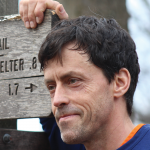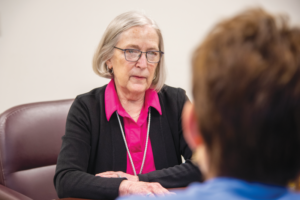By: Jay Evans
Annual Interview Section
I have the honor of sharing insights into the career and life of Christina Grozinger, Distinguished Professor at Pennsylvania State University and Director for the Center for Pollinator Research.
Christina was born in Montreal, Canada, in 1975 and emigrated with her family to the United States in 1978. She returned to Canada to attend McGill University, gaining a dual degree in chemistry and biology, followed by a Ph.D. in Chemistry and Chemical Biology at Harvard University. She developed an interest in honey bee behavior and, naturally, joined Gene Robinson’s honey bee research lab at the University of Illinois, Urbana-Champaign for a postdoctoral fellowship. Christina went from there to North Carolina University for several years before joining Penn State in 2008. Below, she fills in the gaps and gives excellent advice for those interested in a career in science and on the challenges facing bees.
 How did you get into science and who were your mentors on the way?
How did you get into science and who were your mentors on the way?
I loved biology and learning about plants and animals for as long as I can remember. As an undergraduate at McGill Unive in Montreal, I discovered that I loved chemistry too, as a way to learn more about the mechanisms driving the biology of living things. So, I obtained an honors in Chemistry and major in Biology, which probably made my parents very happy as they are both chemists (my father’s work as a pharmaceutical chemist was actually highlighted in the book: Neverapine and the Quest to End Pediatric AIDS). For my graduate studies, I joined the research group of Stuart Schreiber in the Department of Chemistry and Chemical Biology at Harvard University, where I sought to use chemical tools to probe and better study the molecular pathways regulating how cells grow, function, and ultimately die. For my thesis, I studied histone deacetylases, which are key enzymes that regulate gene expression. I loved this research area, but I wanted to find something with broader questions – that would take me decades to answer, if they were even answerable! – to focus on for my future work.
I was interested in the genetic and neurobiological mechanisms regulating behavior, but I did not find most of the “standard” model systems for behavioral neurogenomics very exciting. Around this time, by brother, Stephan Grozinger, started keeping honey bees, and he would tell me fascinating things about their behavior. I then saw a PBS documentary on animal cognition, which included descriptions of bee dance language. I was hooked – this seemed like the perfect system in which to study the genetic mechanisms that regulate instinctive, complex, behaviors. I delved more into the literature of honey bee behavior and realized how endlessly fascinating bees were – and how little information was available about the neurogenomic mechanisms underlying these behaviors.
At the time, new genomic tools were being developed that allowed researchers to study “non standard” models systems, which made it a perfect time to take the leap into this new field. Many of these tools were being developed by Gene Robinson, and I was very fortunate to be awarded a fellowship from the Beckman Institute to join his team. As a postdoctoral fellow, I used these new genomic tools to study how queen pheromone triggers profound behavioral and physiological changes in honey bees.
What’s your favorite honey?
It depends on my mood, and what I am eating it with 🙂
Where have you travelled in your studies of bees, what was most memorable?
Together with Maryann Frazier, Harland Patch (my husband), Elluid Muli, and many other collaborators, I have worked on projects related to honey bee health in Kenya since 2009. I was finally able to actually visit Kenya with Harland and our daughter Evelyn in 2017. This was a fantastic visit, not just to finally meet in person all of our collaborators at ICIPE (the International Centre of Insect Physiology and Ecology) and Southeastern Kenya University, and meet our network of collaborating beekeepers and their bees, but also to finally experience the natural beauty of Kenya.
What are the biggest challenges facing beekeepers moving forward?
Beekeepers have a lot of control over how the manage their own hives, but they do not have much control over what their bees are experiencing, in terms of weather conditions and landscape conditions. Bees fly several kilometers from their hive in search of food, and these distances can increase dramatically if foraging resources are limited. Foraging over long distances can be stressful, and during these flights, bees can be exposed to pesticides, pathogens and parasites. I am working with a team of collaborators from Penn State, University of MN, University of CA, Davis, and Dickinson College on a project funded by the USDA-NIFA-AFRI and Foundation for Food and Agricultural Research to provide beekeepers with an online portal where they can examine their surrounding landscape conditions and obtain predictions for how their bees will fare in different apiary locations, as well as suggested management practices they can use to improve outcomes. This information will also help others – including other stakeholders and policymakers – better understand current conditions for bees in different parts of the U.S., and how these have been changing over time.
What gives you hope? What are the coolest recent discoveries in bee science?
Two things give me a hope – first, there are SO many people interested in helping honey bees and other pollinators, that we are developing a very diverse community that spans multiple perspectives and skill sets to tackle these issues. This community can generate the trans-disciplinary approach that is needed to address bee health issues and help beekeepers. Second, technology is increasing our ability to gather data on both bees and their surroundings, and to analyze these data so we can better understand how to manage bees and our landscapes, despite the fact that there are so many complex and interacting factors impacting bee health.
Who supports your endeavors?
Everyone! My husband, Harland Patch, is a wonderful collaborator and partner, and together we bring different perspectives to many different projects. Our daughter, Evelyn (Evie) Patch, is an enthusiastic advocate for honey bees and pretty much every other insect. Through her efforts there are a lot of elementary school aged children in our town who are eager to help bees, and know what an “entomologist” is. I have been very fortunate to work with a multitude of outstanding collaborators, and mentor many dedicated graduate students and postdoctoral fellows, several of whom now have active research labs of their own and are training the next generation of beekeepers and bee scientists.
Any advice for students entering science?
It is important to find scientific questions that you are passionate about and committed to, and that you feel will have a positive impact on the world around you. This passion and commitment can help you overcome and persist through the numerous hurdles and setbacks that happen with every research study and project. It is also vital to surround yourself with supportive and creative people, who can help you when those setbacks happen and help stretch you into new directions and perspectives.








